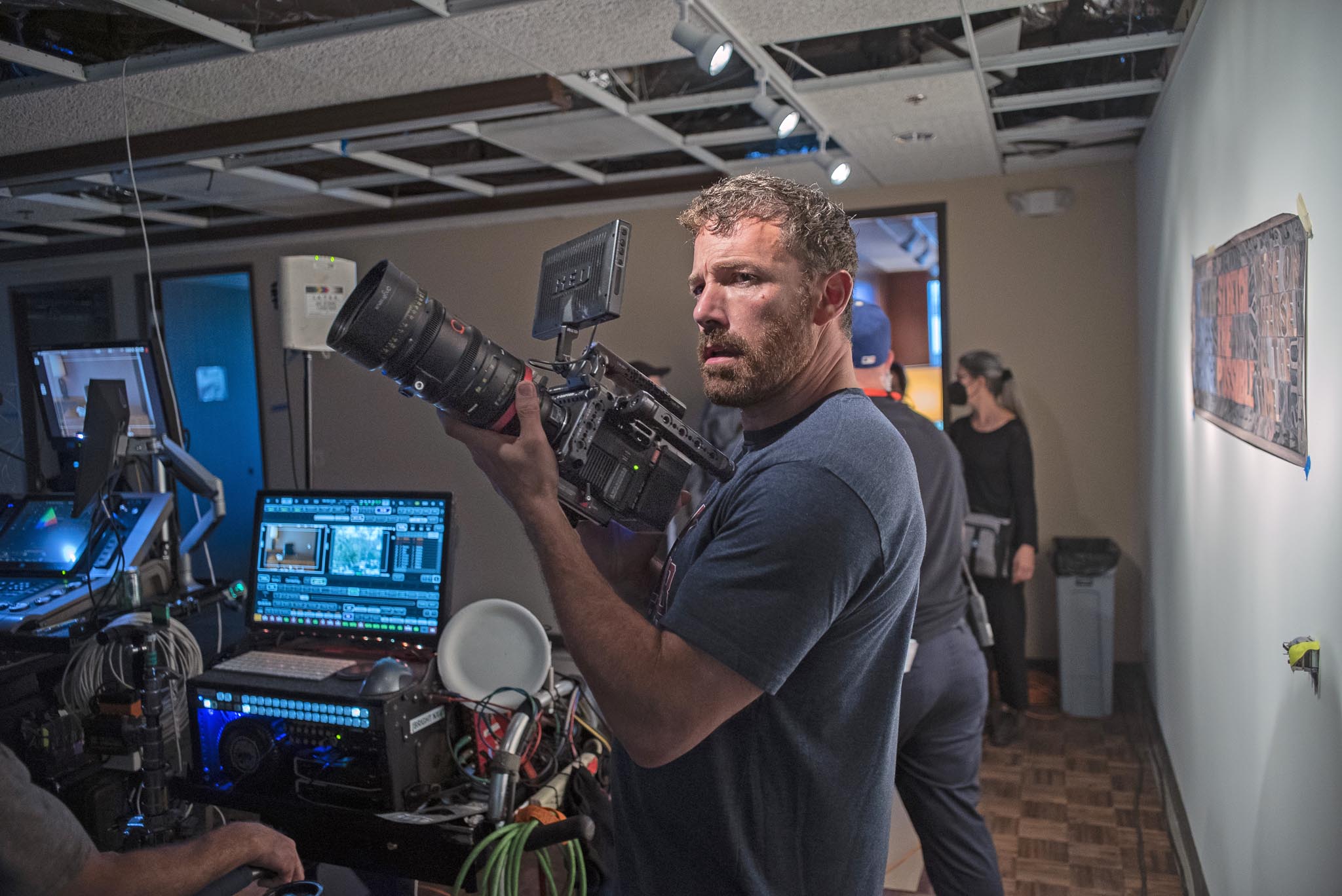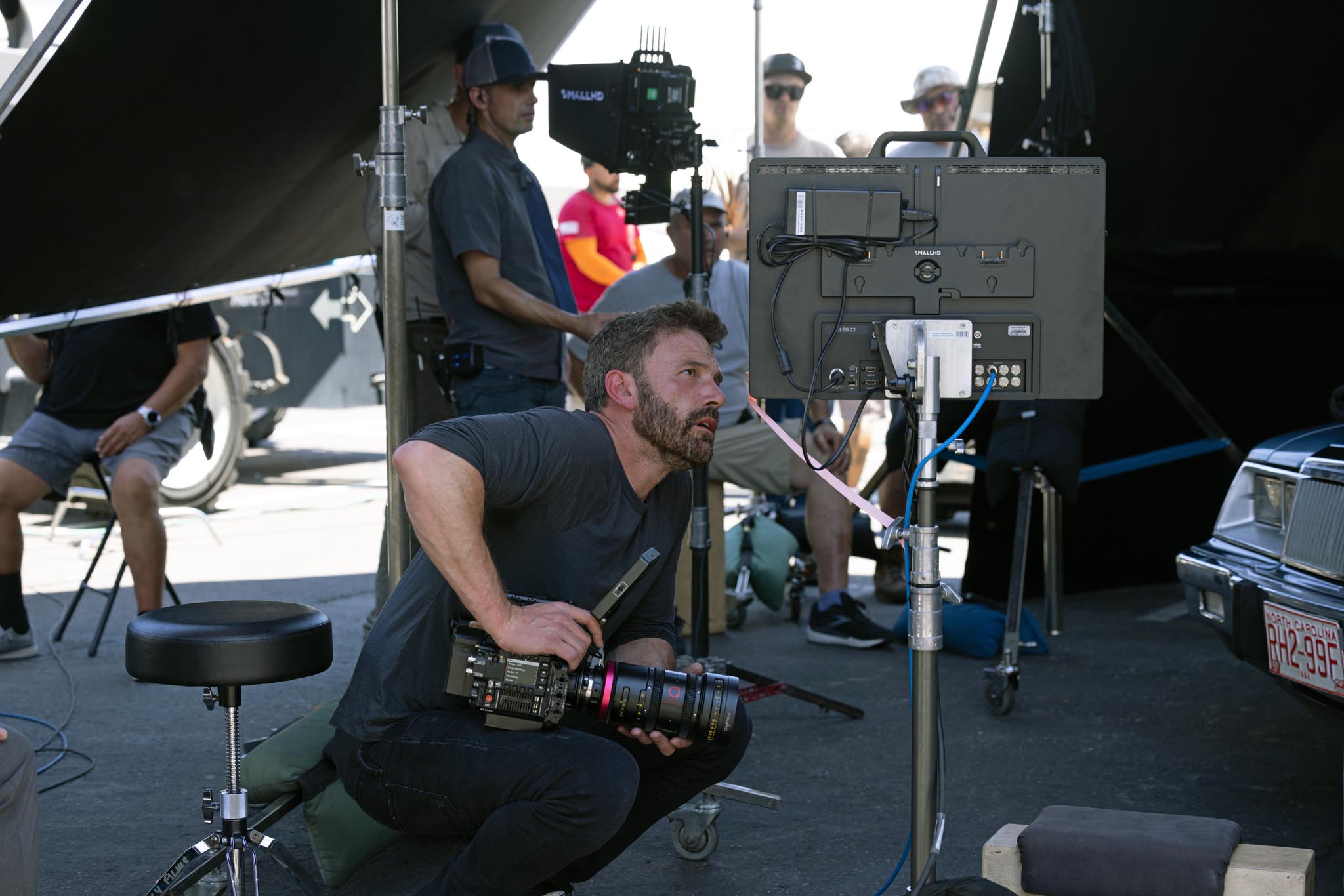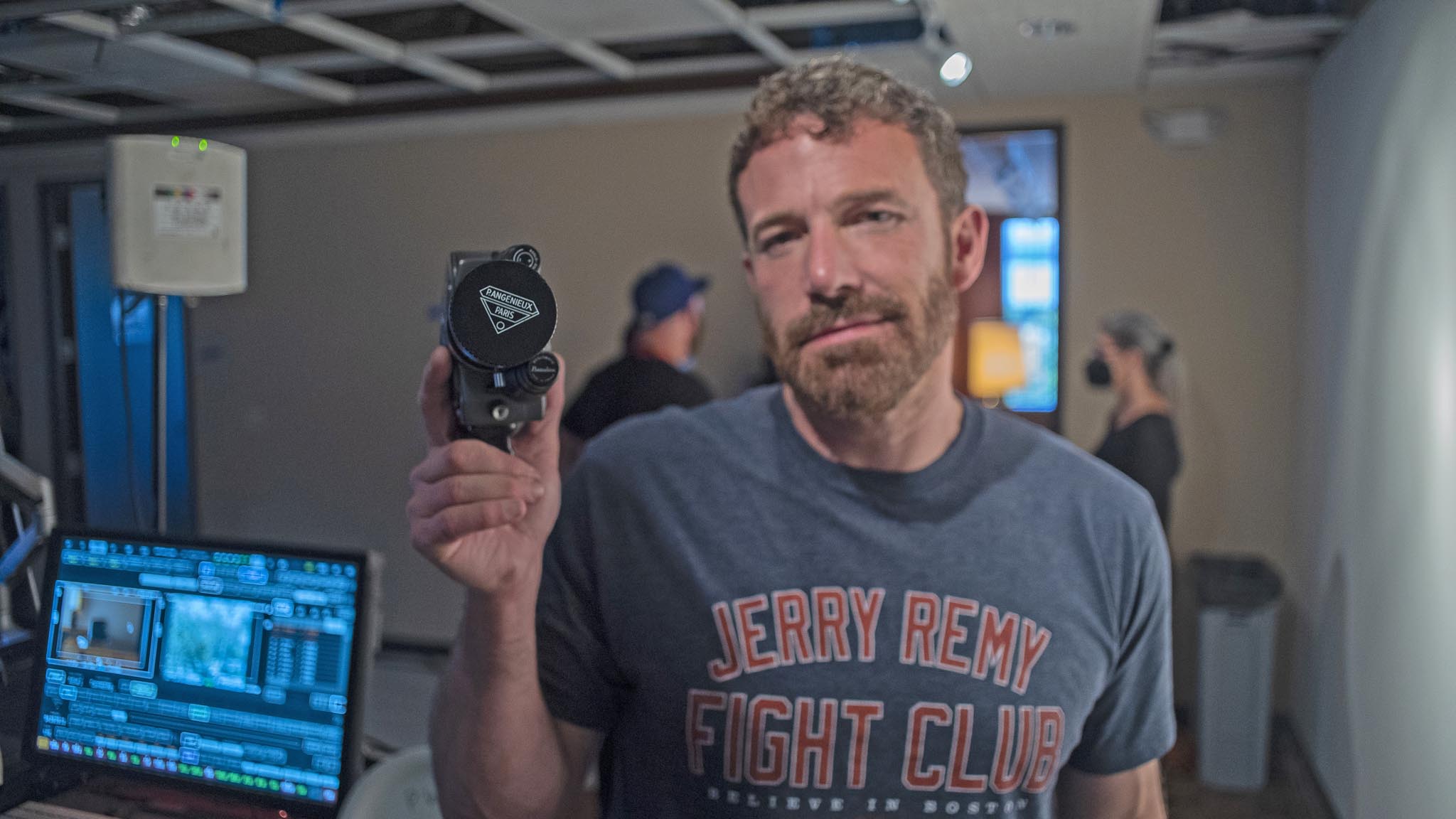
Ben Affleck handheld with RED V-RAPTOR 8K VV and Angénieux Optimo Ultra Compact 28-76 zoom. Photo by Randy Wedick.
Ben Affleck discusses his work directing AIR, shooting “D” camera, and producing the film with co-star Matt Damon and their production company Artists Equity. Bob Richardson, ASC, was the cinematographer.
Jon Fauer: What cameras did you use on AIR?
Ben Affleck: We had the ALEXA 35. I think we were the first or second movie to shoot with it. Chivo and Bruno Delbonnel used them on a series. But I think we were the first movie, and I remember we got three prototype bodies directly from ARRI.
There are photos of you with a RED V-RAPTOR. Is that your personal camera?
We used ARRI ALEXA 35 as the main cameras. I had a RED V-RAPTOR 8K VV with the new Angénieux Optimo Ultra Compact 28-76 T2.9 zoom lens. Bob Richardson, ASC had a set of custom prime lenses from Panavision. They were excellent. In order to integrate with those prime lens and to be at a level to satisfy Bob, I wanted to have a compact zoom that I could use to add to the look of the movie—to add a little bit of the kind of “captured look” of the movie. I used the V-RAPTOR because it’s small enough so that when I wanted to get into certain places, I could handhold it with the Angénieux. So, there were “A,” “B” and “C” ALEXA 35 cameras, and my V-RAPTOR was the “D” camera, effectively.
Part of the reason I had the Angénieux on the V-RAPTOR was because we started production before we could get all the ALEXA 35 bodies. So I tried using the V-RAPTOR and integrating it with the ALEXA 35. It was also interesting to see how to match the color spaces, which were mainly about the skin tones. We often go back and forth. It’s become increasingly difficult to separate RED and ALEXA color spaces. There was a time when I felt they were more distinct. I think RED has really done a great job of approaching the skin tones. But ultimately, we went with the ALEXA 35 as our main cameras for our particular look on this movie.
The benefit for me using the V-RAPTOR was that I could just get in there. The way I operate is that Bob Richardson sets up two cameras. Obviously, he’s brilliant. He’s a genius. He finds where the shots should be. So inherently, by necessity, I have to be somewhere that you wouldn’t normally put a camera.
Then I have to compose, within that space, a different kind of shot than you would typically see. I like to go handheld. Sometimes I’m racking focus, documentary style. I pull focus myself. The reason I like the Ultra Compact Zoom lens is because if I’m focusing myself, going to where my attention is. I’m not having to tell people which actor to focus on.
In the scene with Sonny (Matt Damon) and George Reveling (Marlon Wayans) in the bar, was that you racking focus from one to the other?
That was me, most of it. There was some rack focusing in there. As an actor, I often find myself actually liking my off-camera work a little bit better because I’m more relaxed. Especially early on—maybe the first day—I’ll often just go and shoot. I filmed both Matt and Marlon during the other person’s close-up. It was essentially having them in the foreground—not a close-up single, but pulling to them from the foreground. Often, there’s something about the relaxation that you feel when you just don’t think you’re on camera. It actually gets a little bit looser, sometimes a little ad lib. Maybe it’s just me, but I always feel like, “Gosh, I should have done it like that when I was on camera.” There’s just an extra degree of relaxation, so I don’t want to miss that.
Obviously, on [analog] film, you wouldn’t have been able to do that for obvious reasons. Now, in digital, it’s really more about the quality of light. You’re often working at much lower light levels now. It means that you can get in interesting places. And it really becomes about composition in a lot of ways. I wouldn’t shoot something where Bob doesn’t agree. I always say to Bob, “Anything that I get, if you don’t like it, you can throw it away. I am not the cinematographer; you are by a whole long way. Bob is, I think, one of the greatest ever. It’s a real honor that he kind of tolerated my additional shooting.
Having those moments of performance, “caught moments,” or getting over Matt’s arm and shoulder, just makes it feel a little bit less like a movie to me. It’s kind of half captured and thrown away. I feel that it adds to the authenticity. Not all movies can absorb that. But also, I thought it was an interesting complement to the formality of what Bob does. He can’t help but be masterful. I hate to say it, but a little touch of a much less skilled operator in small doses actually flavors the film in an interesting way. I would never be an “A” or “B” camera operator where my job is to make sure to compose properly every time because I couldn’t be relied on to do it. I’d be doing the actor a disservice because I might have missed a great performance. That’s a problem.
I’ll catch inserts, I’ll get a beer glass filling, the food, environmental cutaways, or stuff in the office. All of that helps fill out a movie where you spend so much more time if you have to go set up for the inserts, and then the entire company stands around while you shoot the sole of a shoe. Whereas, I would just stand there and grab it and the crew might be walking in front of the camera, and I’m just shooting away. I find it very efficient. Also, I don’t have to explain the kind of inserts I want or the way to do it, or start here and rack focus to that.
However, sometimes I do want a very specific kind of insert, for example, when Sonny is in the room at night in the office. You have all those little library type bankers’ lamps on the tables, which was a cheat that I just allowed ourselves to have because I thought they were pretty.
Were you mixing Super 35 from Bob’s ALEXA 35 camera and Full frame on your V-RAPTOR VV?
No, because we matched formats and the RED sensor mode was cropped to match the size of the ALEXA 35.
Oh, you were in Super35 for all cameras?
Yes. So that it remained consistent. You want to have the same framing. Otherwise it can become awkward. We had a brilliant colorist, Élodie Ichter at Picture Shop. She is a genius. She did magical things integrating the RED footage with the ALEXA. Bob found her and I see why, because she’s amazing. She was able to beautifully apply the LUT and apply grain specifically to the red, green, and blue components of the image. Because with original film stock, of course, the red, green and the blue layers had different degrees of photosensitivity.

Ben Affleck with RED V-RAPTOR 8K VV and Angénieux Optimo Ultra Compact 28-76 zoom, viewing on SmallHD OLED 22 monitor. Photo by Ana Carballosa.
Were you always interested in cameras and lenses?
Yes. I’ve been a photographer since high school and I’ve always loved it. It’s in my blood. I’m always taking photographs. I have amazing Super8 footage of shooting Good Will Hunting. My brother and I took a 16mm camera across the country. I’ve always loved film and photography. The great joy now is our new company, Artists Equity. The idea is equity and ownership. I own the company but don’t take a salary. I’m aligned with the company’s interests and this is a symbol of how we want how artists to be compensated. But our real secret salary is that we mostly own our own gear. We buy the lenses, the bodies and then rent them back to the production. But it’s really just so that I can expand my collection. The Angénieux Ultra Compact zoom is an example. I won’t mention any other specific lenses.
Feel free. FDTimes is equal equipment opportunity and our logo color is Swiss Army Knife neutrality.
Well, over the the years I have accumulated a collection of vintage lenses that I bring to the company. Because, as the cameras get more resolution, there can be a crispness veering towards football game or a newscast video that works against the combination of old glass and the motion blur of film, which gave you a bit of a distance. I think it helps suspend disbelief. I don’t think that resolution itself is bad because if it’s well lit, the resolution can actually give you smoother details and pleasing fall-off.
I have a set of Canon K35s that are rehoused. They are unbelievable. I have ZEISS Ultra Primes and Super Speeds. I have some old ARRI/FUJINON Alura Zooms and crazy Russian lenses from the ‘50s that I got off eBay.
Amazing. I had no idea you were a member of our camera and lens geek society.
Man, I get made fun of. It’s a very serious addiction.
Why are others not doing this—sort of going back to the days when the studios and production companies had in-house camera departments and owned the equipment?
I don’t know why not. I think that stopped once the studios got broken up. But still, we work with rental houses. We’re not looking to put rental houses out of business because there’s always something somebody wants to rent. In particular, the camera bodies.
This will continue to bud. You buy one and then the next one. ALEXA, V-RAPTOR, VENICE 2 are great, and there’ll be another. They’re always innovating. But the glass is something worth collecting. Look at Panavision. Some of the lenses we used for AIR are from Ben-Hur. They have some beautiful glass. The age and quality of the glass does have an effect. Vintage lenses can be especially good in Full Frame format with its high resolution 8K. I just love it. It’s definitely compulsive.
We also own all our post production equipment. Even post here is in-house. It allows us to offer the means for artists on limited budgets to really try to do it for less. We go, “Here, take the gear. Here are the cameras, the lenses, the stuff.”
When we were doing Good Will Hunting, the logic was, well, you needed a million dollars just for a camera body and film. It was about 60 cents a foot to buy the film, 60 cents to process, and then the cost of the workprint. And lots of lights just to get an exposure. These were hard costs. Now, I feel that if we give you a camera and lens, you should be able to make a movie. That’s why I’m really grateful to have that Angénieux Optimo Ultra Compact zoom. I love it—it’s really the best handheld zoom for me. If you want to be most versatile and still have something that can cut with the most elegant glass, you really cannot do better than that.
What did Bob Richardson ultimately think about your having a different lens than the Panavision lenses he was using?
I’m very respectful and deferential. I only know enough about photography to know how much better Bob is than I.
But it cut well. Vintage Panavision primes and a contemporary Angénieux zoom worked well together.
They did. Bob knew that I was respectful of it, that I understood how he was lighting and understood the look and was not going to violate it. I also knew that he was looking at it and grading it. If there was something he had a problem with, he could, obviously, mark it and grade it, or get rid of it. Bob was grading as we went along on the set. Of course, there was a show LUT. But, we had a physical grading suite on set where he worked with the colorist as we were shooting, which was extremely useful.
I think, probably, in his heart of hearts, Bob would have liked a more professional operator than me since he is used to working with the very best. I’m no Colin Anderson [Camera Operator on AIR], that’s for sure. And I’m not as good as Bob. But I am good enough that some of the stuff can end up in the movie and, as I said, I know enough to appreciate how much work goes into being a great cinematographer like Bob.
There was a nice immediacy that you also had in “Argo.”
Yeah. That was another movie where we used all kinds of cameras and lenses—anamorphic, spherical, film bodies, ALEXA, Super8. We used almost every format you can shoot in, each distinct to a certain location—the CIA, Iran, Turkey, Hollywood. They all had different looks, lenses, bodies and style. They gave you a sense of different worlds, hopefully.
Thanks to Gigi Fouquet and Chay Carter at Artists Equity; Randy Wedick at Angénieux Americas / Band Pro.








